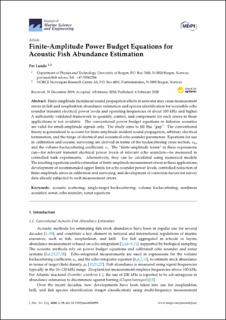Finite-Amplitude Power Budget Equations for Acoustic Fish Abundance Estimation
Journal article, Peer reviewed
Published version

Åpne
Permanent lenke
https://hdl.handle.net/11250/2739643Utgivelsesdato
2020Metadata
Vis full innførselSamlinger
Sammendrag
Finiteamplitude (nonlinear) sound propagation effects in seawater may cause measurement errors in fish and zooplankton abundance estimation and species identification for accessible echo sounder transmit electrical power levels and operating frequencies of about 100 kHz and higher. A sufficiently validated framework to quantify, control, and compensate for such errors in these applications is not available. The conventional power budget equations in fisheries acoustics are valid for smallamplitude signals only. The study aims to fill this “gap”. The conventional theory is generalized to account for finite-amplitude incident sound propagation, arbitrary electrical termination, and the range of electrical and acoustical echo sounder parameters. Equations for use in calibration and oceanic surveying are derived in terms of the backscattering cross section, and the volume backscattering coefficient,. The “finite-amplitude terms” in these expressions can—for relevant transmit electrical power levels of relevant echo sounders—be measured in controlled tank experiments. Alternatively, they can be calculated using numerical models. The resulting equations enable estimation of finite-amplitude measurement errors in these applications; development of recommended upper limits for echo sounder power levels; controlled reduction of finite-amplitude errors in calibration and surveying; and development of correction factors for survey data already subjected to such measurement errors.
